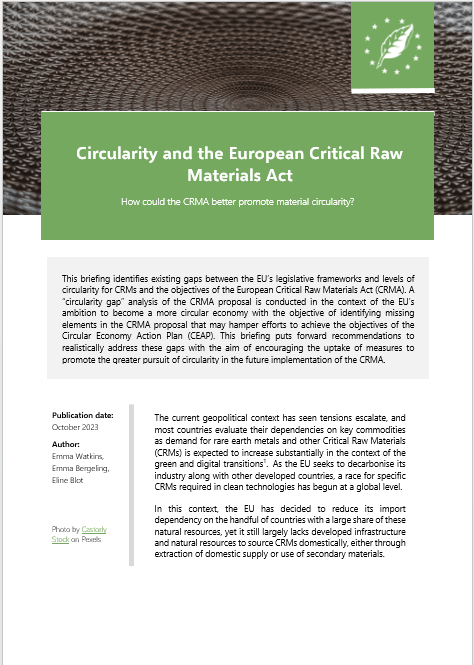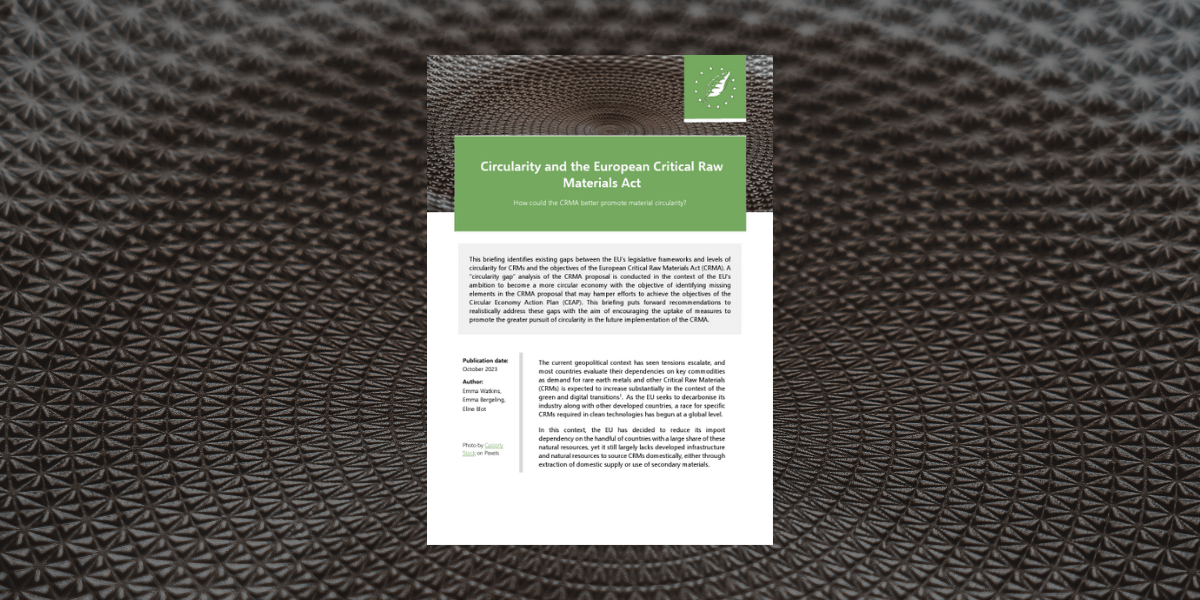AUTHORS: Emma Watkins, Emma Bergeling, Eline Blot
This briefing considers how circularity can support the targets proposed in the European Critical Raw Materials Act (CRMA), and proposes recommendations for measures that could help to realistically achieve these targets while promoting a more circular economy.
Geopolitical tensions have escalated as most countries evaluate their dependencies on the critical raw materials (CRMs) necessary to produce clean technologies and deliver the green and digital transitions. In response, the European Commission published its proposal for a European Critical Raw Materials Act (CRMA) which seeks to both reduce EU dependency on a handful of countries with a large share of these natural resources and increase the sourcing of CRMs domestically through extraction, processing and recycling. However, the EU largely lacks the infrastructure and framework to support the expansion of domestic sourcing of CRMs.
Growing EU demand for clean technologies will be accompanied by growth in demand for the material resources needed to produce them. Yet the EU’s material footprint of 14.5 tonnes per capita needs to be halved to remain within planetary boundaries and amount to an equitable share of the earth’s resources.
Therefore, in a Paris-compatible future – guided by the SDGs – the objectives of the CRMA should be based primarily on the principles of circularity, to reduce overall environmental impact and material use, and increase efficient use of CRMs through measures related to design, repair, reuse, recovery and recycling. As well as decreasing its material footprint, reduced resource use and demand would also alleviate the EU’s reliance on imported and domestically mined CRMs.
Circular economy-related provisions in the CRMA proposal are mainly concentrated on leveraging post-consumer waste. This includes improving recycling processes and capacity and increasing the reuse of products and secondary CRMs through minimum recycled content requirements.
The main circularity-related target in the CRMA is to meet 15% of the EU’s annual consumption of strategic raw materials through domestic recycling capacity. However, this briefing highlights that the average end-of-life recycling input rate across the 34 CRMs in the EU is only 8.3%. There is therefore still some way to go to meet the CRMA’s recycling capacity target.
More needs to be done to improve circularity – and in particular recovery and recycling – to achieve the CRMA’s recycling objective. In addition, the overall high levels of resource use in the EU must be addressed, to ensure that CRMs are used as efficiently as possible.
This briefing identifies five key circularity gaps:
- Inadequate product design for circularity
- Lack of information on product composition and materials
- Low collection and recycling rates
- Inadequate recycling facilities, technologies, and economic viability
- High levels of resource use
The briefing then makes several recommendations to help tackle these gaps, including:
- Introducing more clarity on how to consider the recovery potential for CRMs in Ecodesign requirements developed under the ESPR.
- Ensuring coherence between the CRMA and product and waste legislation with regards to promoting circularity of CRMs, including collection, recovery and recycling targets.
- Ensuring that CRM-containing products and waste streams already covered by EU legislation do not lag behind in terms of their circularity potential.
- Emphasising the value of clear product labelling and product passports in enabling circularity, and potentially requiring all products with viable recoverable amounts of CRMs to bear a label or have a product passport.
- Considering the development of targets specific to individual SRMs for the proportion that should come from the EU’s recycling capacity by 2030.
- Assessing whether existing EU-level funds will be adequate to provide the necessary financial support to MS to achieve the CRMA’s objectives.
- Developing BREFs or other EU-level guidance on CRM recycling technologies.
- Promoting the use of market-based instruments, such as extended producer responsibility with eco-modulated fees, or product or material taxes, to send price signals in support of recycling and the use of secondary CRMs.
- Supporting the development of economies of scale for CRM recycling.
- Ensuring absolute rather than relative assessment of progress towards resource consumption within planetary boundaries, by utilising all available circular economy strategies including circular business models.
- Keeping a dual focus on decarbonisation and dematerialisation by setting science-based targets for reduced primary resource use.
Event | 8th November | Identifying the circularity gaps of the European Critical Raw Materials Act
Blog | We need a Critical Materials Regulation, not a raw materials’ boosting act
Photo by Chris Curry on Unsplash



